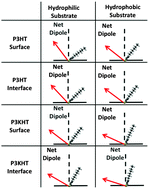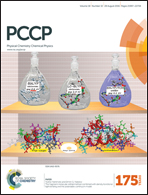Influence of the side chain and substrate on polythiophene thin film surface, bulk, and buried interfacial structures†
Abstract
The molecular structures of organic semiconducting thin films mediate the performance of various devices composed of such materials. To fully understand how the structures of organic semiconductors alter on substrates due to different polymer side chains and different interfacial interactions, thin films of two kinds of polythiophene derivatives with different side-chains, poly(3-hexylthiophene) (P3HT) and poly(3-potassium-6-hexanoate thiophene) (P3KHT), were deposited and compared on various surfaces. A combination of analytical tools was applied in this research: contact angle goniometry and X-ray photoelectron spectroscopy (XPS) were used to characterize substrate dielectric surfaces with varied hydrophobicity for polymer film deposition; X-ray diffraction and UV-vis spectroscopy were used to examine the polythiophene film bulk structure; sum frequency generation (SFG) vibrational spectroscopy was utilized to probe the molecular structures of polymer film surfaces in air and buried solid/solid interfaces. Both side-chain hydrophobicity and substrate hydrophobicity were found to mediate the crystallinity of the polythiophene film, as well as the orientation of the thiophene ring within the polymer backbone at the buried polymer/substrate interface and the polymer thin film surface in air. For the same type of polythiophene film deposited on different substrates, a more hydrophobic substrate surface induced thiophene ring alignment with the surface normal at both the buried interface and on the surface in air. For different films (P3HT vs. P3KHT) deposited on the same dielectric substrate, a more hydrophobic polythiophene side chain caused the thiophene ring to align more towards the surface at the buried polymer/substrate interface and on the surface in air. We believe that the polythiophene surface, bulk, and buried interfacial molecular structures all influence the hole mobility within the polythiophene film. Successful characterization of an organic conducting thin film surface, buried interfacial, and bulk structures is a first crucial step in understanding the structure–function relationship of such films in order to optimize device performance. An in-depth understanding on how the side-chain influences the interfacial and surface polymer orientation will guide the future molecular structure design of organic semiconductors.


 Please wait while we load your content...
Please wait while we load your content...